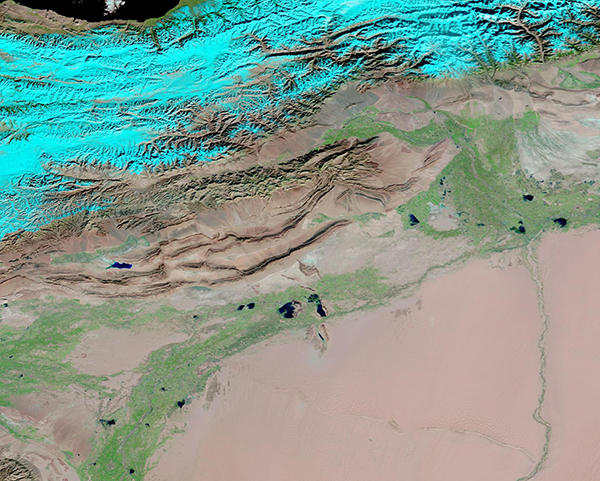Images
November 30, 2023 - Winter in the Taklimakan Desert
Tweet
Western China’s Taklimakan Desert is a land of extremes. Frigid, arid winter nights can drop below −4°F (-20°C), while summertime heat often rises to 104°F (40 °C) or more. Rainfall is extremely sparse, with the central basin receiving less than 10 millimeters (0.4 inches) of precipitation each year. Few plants can survive in such a parched environment, yet in the summertime runoff from the snowpack atop the Tien Shan and Kunlun Shan mountains feeds rivers that stretch into the desert, creating a flush of vegetation.
The Moderate Resolution Imaging Spectroradiometer (MODIS) on NASA’s Terra satellite acquired two false-color images of the Taklimakan Desert that illustrate the changes between winter (November 21, 2023) and summer (August 19, 2023). To compare the images, simply click on the dates.
This type of false-color image combines infrared and visible light (MODIS bands 7,2,1) to help separate snow (electric blue) from cloud (white), standing water (darker blue), vegetation (bright green), and barren land (tan or brown).
In the November image, winter snow covers the nearby mountains, while sparse vegetation rings the dry desert sand. The only river visible, the Hotan River, which snakes southward through the desert, appears very narrow with only a small amount of green on its banks. The August image shows a much different scene. Although snow is greatly diminished, the Hotan River is filled with water, as are several ephemeral rivers, including the Yarkant River to the west. Vegetation is also relatively lush, as illustrated by the bright wash of green across desert edges and around rivers.
Image Facts
Satellite:
Terra
Date Acquired: 11/21/2023
Resolutions:
1km (338.3 KB), 500m (915.7 KB), 250m (654.2 KB)
Bands Used: 7,2,1
Image Credit:
MODIS Land Rapid Response Team, NASA GSFC
Tweet
Western China’s Taklimakan Desert is a land of extremes. Frigid, arid winter nights can drop below −4°F (-20°C), while summertime heat often rises to 104°F (40 °C) or more. Rainfall is extremely sparse, with the central basin receiving less than 10 millimeters (0.4 inches) of precipitation each year. Few plants can survive in such a parched environment, yet in the summertime runoff from the snowpack atop the Tien Shan and Kunlun Shan mountains feeds rivers that stretch into the desert, creating a flush of vegetation.
The Moderate Resolution Imaging Spectroradiometer (MODIS) on NASA’s Terra satellite acquired two false-color images of the Taklimakan Desert that illustrate the changes between winter (November 21, 2023) and summer (August 19, 2023). To compare the images, simply click on the dates. This type of false-color image combines infrared and visible light (MODIS bands 7,2,1) to help separate snow (electric blue) from cloud (white), standing water (darker blue), vegetation (bright green), and barren land (tan or brown).
In the November image, winter snow covers the nearby mountains, while sparse vegetation rings the dry desert sand. The only river visible, the Hotan River, which snakes southward through the desert, appears very narrow with only a small amount of green on its banks. The August image shows a much different scene. Although snow is greatly diminished, the Hotan River is filled with water, as are several ephemeral rivers, including the Yarkant River to the west. Vegetation is also relatively lush, as illustrated by the bright wash of green across desert edges and around rivers.
Image Facts
Satellite:
Terra
Date Acquired: 11/21/2023
Resolutions:
1km (338.3 KB), 500m (915.7 KB), 250m (654.2 KB)
Bands Used: 7,2,1
Image Credit:
MODIS Land Rapid Response Team, NASA GSFC





